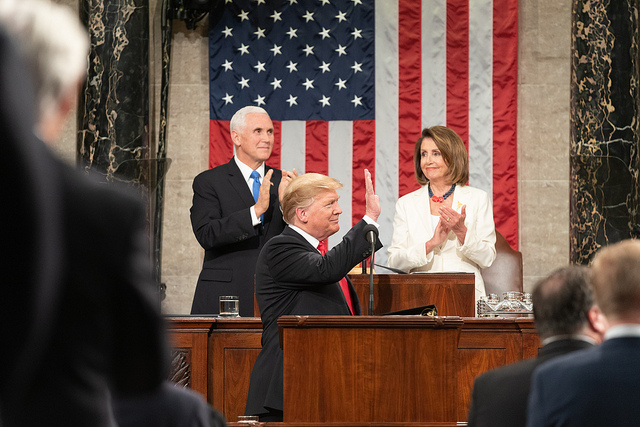
If the past year is any indication of the year ahead, US policy in Asia will be erratic and self-serving. The beginnings of an Indo-Pacific strategy notwithstanding, the Trump administration continues to work out its issues with countries in the region bilaterally and sporadically.
Donald Trump’s trade confrontation with China is yet to produce a negotiated solution. The challenge is structural and no amount of Chinese promises to ‘buy American’ will fix the underlying problems.
The challenge posed by Chinese companies is felt far beyond the US government. The Department of Justice’s enforcement of US law on companies accused of commercial espionage and cyber theft is only strengthening. Beyond the high-profile detention in Canada and pending extradition of Huawei’s CFO Meng Wanzhou, numerous indictments of Chinese companies are being pursued.
Without real change in Beijing’s enforcement of intellectual property theft, simply shifting the trade balance towards a more favourable direction for the United States will be insufficient to address the economic strain.
Trump’s approach to China is not only about commerce. Vice President Mike Pence’s speech in October made that clear. A wide-ranging critique of China’s behaviour in the US and efforts to expand its influence abroad, the speech was welcomed by some in Asia as evidence that the US is ready to stand up to China.
But across the Indo-Pacific a more openly pugilistic US relationship with China unsettles nerves. Is it a ‘new cold war’? Not yet, but the US and China are clearly on a deeply contentious path. It’s an open question whether Washington is up to the challenge of engaging in sustained, strategic competition with Beijing and whether it can maintain the like-minded regional coalition that will be necessary.
A second challenge for Washington is realising the promise of threat reduction claimed by Trump and North Korean leader Kim Jong-un in Singapore. The president is fond of declaring his administration’s diplomacy with Kim a success, but his own intelligence agencies disagree that North Korea is prepared to denuclearise.
Over the past year, to be sure, there were no missile or nuclear tests. Yet there was also no progress in getting Pyongyang to catalogue its nuclear and missile facilities or to open its production sites for international inspection. The on-again, off-again diplomacy to set up a second summit suggested a major setback. But Trump and Kim will now meet in Vietnam on 27 and 28 February.
Perhaps the most pervasive problem for US foreign-policymakers is not the behaviour of other global actors, in Asia or elsewhere. Crippling divisions within the Trump administration itself, and between the administration and the legislative and judicial branches of the US government, could make any attempt to marshal US resources into foreign relations almost impossible.
With the government shutdown, the Mueller investigation and its criminal indictments, and the increased scrutiny of Congress on the administration, it will be a year of domestic entanglement for the president and his White House.
The foreign policy consequences of this domestic turbulence cannot be overlooked. Already, the Trump administration’s decision-making has led to the loss of advisers with critical foreign policy expertise, such as former defence secretary Jim Mattis. There also seems to be a much-diminished capacity within the White House for organised intra-agency debate over US strategic priorities.
Some think that the president is now more empowered to act in line with his ambitions, and so foreign policy will become more aligned with his ‘America First’ premise. Perhaps that’s true. But even if there are fewer experts in the government to challenge Trump’s vision, he will still have to implement his goals. And that may become more difficult than ever.
Frustrations at home could just as easily produce even more brittle and reactive decision-making by the president, making it impossible to reach or implement meaningful agreements with others around the globe. Also worrisome is that, with all this domestic contest, the Trump administration will be overly eager to create evidence of foreign policy successes. Prematurely declaring victory in the trade war with China or in negotiations with North Korea could leave the region, and the globe, less stable.
As former deputy secretary of state Antony Blinken pointed out, for all the Trump administration’s breathless talk of crises, the president has yet to face a real challenge to US interests. A crisis could expose the administration’s haphazard decision-making procedures and its intragovernmental divisions. Congress is growing more active in trying to assert its role in a crisis, with some members proposing limits on the president’s use of nuclear weapons.
US success in mitigating strategic tensions with China is unlikely, and no US president has yet found the magic solution to persuading Pyongyang to abandon its nuclear quest.
Nor does Washington seem well placed to assist its friends and allies with their own problems. Of particular concern is the deteriorating relationship between Japan and South Korea. This is a moment that cries out for diplomatic assistance from countries like the US, which see what the heightened risk of a military clash could mean for the future of Northeast Asia.
Add to that the alarming signs that Trump really does want to step back from US treaty commitments to allies in NATO, South Korea and perhaps even Japan, and 2019 could end up being a far bigger watershed in US policy towards Asia than anyone cares to imagine.

